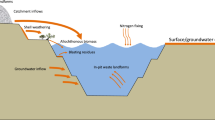Abstract
Water and dissolved nitrogen flows through the hyporheic zone of a 3rd-order mountain stream in Hokkaido, northern Japan were measured during a small storm in August 1997. A network of wells was established to measure water table elevations and to collect water samples to analyze dissolved nitrogen concentrations. Hydraulic conductivity and the depth to bedrock were surveyed. We parameterized the groundwater flow model, MODFLOW, to quantify subsurface flows of both stream water and soil water through the hyporheic zone. MODFLOW simulations suggest that soil water inflow from the adjacent hill slope increased by 1.7-fold during a small storm. Dissolved organic nitrogen (DON) and ammonium (NH +4 ) in soil water from the hill slope were the dominant nitrogen inputs to the riparian zone. DON was consumed via mineralization to NH +4 in the hyporheic zone. NH +4 was the dominant nitrogen species in the subsurface, and showed a net release during both base and storm flow. Nitrate appeared to be lost to denitrification or immobilized by microorganisms and/or vegetation in the riparian zone. Our results indicated that the riparian and hyporheic system was a net source of NH +4 to the stream.
Similar content being viewed by others
References
Bouwer H. 1989. The Bouwer and Rice slug test – an update. Groundwater 27: 304–309.
Bouwer H. and Rice R.C. 1976. A slug test for determining hydraulic conductivities of unconfined aquifers with completely or partially penetrating wells. Water Resour. Res. 12: 423–428.
Chestnut T.J. and McDowell W.H. 2000. C and N dynamics in the riparian and hyporheic zones of a tropical stream, Luquillo Mountains, Puerto Rico. J. North Am. Benthological Soc. 19: 199–214.
Cirmo C.P. and McDonnell J.J. 1997. Linking the hydrologic and biogeochemical controls of nitrogen transport in near-stream zones of temperate-forested catchments: a review. J. Hydrol. 199: 88–120.
Dawson K.J. and Istock J.D. 1991. Aquifer Testing: Design and Analysis of Pumping and Slug Tests. Lewis Publishers, Chelsea, Michigan.
Findlay S. 1995. Importance of surface–subsurface exchange in stream ecosystems: the hyporheic zone. Limnol. Oceanogr. 40: 159–164.
Hedin L.O., von Fischer J.C., Ostrom N.E., Kennedy B.P., Brown M.G. and Robertson G.P. 1998. Thermodynamics constraints on nitrogen transformations and other biogeochemical processes at soil– stream interfaces. Ecology 79: 684–703.
Hill A.R. 1996. Nitrate removal in stream riparian zones. J. Environ. Qual. 25: 743–755.
Jandik P. and Bonn G. 1993. Capillary Electrophoresis of Small Molecules and Ions. VCH Publishers, New York, 298 p.
McDonald M.G. and Harbaugh A.W. 1988. A model three-dimensional finite-difference ground-water flow model. In: US Geological Survey (ed) Techniques of Water-Resource. Investigation of the USGS Book 6. USGS, Denver.
McDowell W.H., Bowden W.B. and Asbury C.E. 1992. Riparian nitrogen dynamics in two geomorphologically distinct tropical rain forest watersheds: subsurface solute patterns. Biogeochemistry 18: 53–75.
Morris D.A. and Johnson A.I. 1967. Summary of hydrologic and physical properties of rock and soil materials as analyzed by Hydrologic Laboratory of the U.S. Geological Survey, USGS, Water Supply Paper 1839-D, 1948–1960.
Shin J. 1989. Jisuberi Kogaku (Landslide Engineering), Sankaido, Tokyo, pp. 482–495 (in Japanese).
The Japan Society for Analytical Chemistry, Hokkaido Branch 1994. Analysis of Water. 4th edn, Kagaku Dojin, Kyoto, pp. 266–269 (in Japanese).
Triska F.J., Kennedy V.C., Avanzio R.J., Zellweger G.W. and Bencala K.E. 1989. Retention and transport of nutrients in a third-order stream in northwestern California: Hyporheic processes. Ecology 70: 1893–1905.
Triska F.J., Duff J.H. and Avanzino R.J. 1990. Influence of exchange flow between the channel and hyporheic zone on nitrate production in a small mountain stream. Canadian J. Fish. Aq. Sci. 47: 2099–2111.
Triska F.J., Duff J.H. and Avanzino R.J. 1993. The role of water exchange between a stream channel and its hyporheic zone in nitrogen cycling at the terrestrial–aquatic interface. Hydrobiologia 251: 167–184.
Vervier P., Roques L., Baker M.A., Garabetian F. and Auriol P. 2002. Biodegradation of dissolved free simple carbohydrates in surface, hyporheic and riparian waters of a large river. Arch. Hydrobiol. 153: 595–604.
Wondzell S.M. and Swanson F.J. 1996a. Seasonal and storm dynamics of the hyporheic zone of a 4th-order mountain stream. I: hydrologic processes. J. N. Am. Bentho. Soc. 15: 3–19.
Wondzell S.M. and Swanson F.J. 1996b. Seasonal and storm dynamics of the hyporheic zone of a 4th-order mountain stream. II: nitrogen cycling. J.N. Am. Bentho. Soc. 15: 20–34.
Rights and permissions
About this article
Cite this article
Shibata, H., Sugawara, O., Toyoshima, H. et al. Nitrogen dynamics in the hyporheic zone of a forested stream during a small storm, Hokkaido, Japan. Biogeochemistry 69, 83–104 (2004). https://doi.org/10.1023/B:BIOG.0000031042.90585.0a
Issue Date:
DOI: https://doi.org/10.1023/B:BIOG.0000031042.90585.0a




